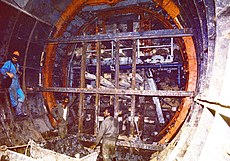Netaji metro station
Netaji Metro Station is a station of the Kolkata Metro.[2][3] This station is situated opposite to the Kudghat bus stand at Kudghat, in Tollygunge.
History[edit]
Early attempts[edit]
In the September 1919 session of the Imperial Legislative Council at Shimla, a committee was set up by W. E. Crum that recommended a metro line for Kolkata (formerly Calcutta).[4] This line was supposed to connect Bagmari in the east to Benaras Road, Salkia, in Howrah in the west via a tunnel beneath Hooghly River. The estimated construction costs were £3,526,154, about ₹36.4 crore (US$4.2 million) based on current exchange rates, and the proposed deadline was 1925–1926. The proposed line was 10.4 km (6.5 mi) long, about 4 km (2.5 mi) shorter than the current East-West Corridor, which would connect East Bengal Railway in Bagmari and East Indian Railway in Benaras Road. The tickets were priced at 3 annas (Rs. 0.1875) for the full trip. Crum also mentioned a north–south corridor back then. An east–west metro railway connection, named the "East–West Tube Railway", was proposed for Kolkata in 1921 by Harley Dalrymple-Hay. All the reports can be found in his 1921 book Calcutta Tube Railways. However, in 1923, the proposal was not undertaken due to a lack of funds.[5][4][6]
Planning[edit]
The then Chief Minister of West Bengal, Bidhan Chandra Roy, reconceived the idea of an underground railway for Kolkata in the early 1949–1950. A survey was done by a team of French experts, but nothing concrete came of this. Efforts to solve problem traffic by augmenting the existing fleet of public transport vehicles hardly helped, since roads accounted for only 4.2 percent of the surface area in Kolkata, compared with 25 percent in Delhi and 30 percent in other cities. To find alternative solutions, the Metropolitan Transport Project (MTP) was set up in 1969. The MTP, with the help of Soviet specialists, Lenmetroproekt and East German engineers, prepared a master plan to provide five rapid-transit (metro) lines for the city of Kolkata, totaling a length of 97.5 km (60.6 mi), in 1971.[7] However, only three were selected for construction. These were:[8][9]
- Dum Dum – Tollygunge (Line 1. Presently operates from Dakshineswar to New Garia)
- Bidhannagar – Ramrajatala (Line 2. Presently truncated till Howrah Maidan)
- Dakshineswar – Thakurpukur (Divided into Line 1; Noapara to Dakshineswar and Line 3; Joka to Esplanade)
The highest priority was given to the busy north–south corridor between Dum Dum and Tollygunge over a length of 16.45 km (10.22 mi); work on this project was approved on 1 June 1972. A tentative deadline was fixed to complete all the corridors by 1991.[10]
Construction[edit]

Since it was India's first metro[11] and was constructed as a completely indigenous process, a traditional cut-and-cover method and driven shield tunneling was chosen and the Kolkata Metro was more of a trial-and-error affair, in contrast to the Delhi Metro, which saw the involvement of multiple international consultants. As a result, it took nearly 23 years to completely construct the 17 km (11 mi) underground railway.[9][12]
The foundation stone of the project was laid by Indira Gandhi, the Prime Minister of India, on 29 December 1972, and construction work started in 1973–74. Initially, cut and cover along with slurry wall construction to handle soft ground, was recommended by the Soviet Union Consultants. Later, in 1977, it was decided to adopt both shield tunneling and cut and cover methods for construction under populated areas, sewer lines, water mains, electrical cables, telephone cables, tram lines, canals etc. The technology was provided by M/s NIKEX Hungarian Co., Budapest.[13] In the early days, the project was led by the Union Railway Minister from West Bengal, A. B. A. Ghani Khan Choudhury, often against the prevailing socio-political stance of his contemporaries in the West Bengal government. From the start of construction, the project had to contend with several problems including insufficient funds (until 1977–1978), a shifting of underground utilities, court injunctions, and an irregular supply of vital materials.[9][14] In 1977, an injunction for the allocation of new funding was passed by the newly elected Jyoti Basu government.[15]
Despite all the hurdles, services began on 24 October 1984, with the commissioning of a partial commercial service covering a distance of 3.40 km (2.11 mi) with five stations served between Esplanade and Bhowanipur (currently Netaji Bhavan).[7] The first metro was driven by Tapan Kumar Nath and Sanjoy Kumar Sil.[16] The service was quickly followed by commuter services on another 2.15 km (1.34 mi) stretch in the north between Dum Dum and Belgachhia on 12 November 1984. The commuter service was extended to Tollygunge on 29 April 1986, covering a further distance of 4.24 km (2.63 mi), making the service available over a distance of 9.79 km (6.08 mi) and covering 11 stations. However, the services on the north section were suspended starting 26 October 1992, as this small, isolated section was little used.[14] The Line 1 was almost entirely built by cut and cover method, while a small 1.09 km stretch between Belgachia and Shyambazar was built using shield tunneling with compressed air and air locks, since the alignment crossed a railway yard (now Kolkata railway station) and Circular Canal.[13][17][18]
After more than eight years, the 1.62 km (1.01 mi) Belgachhia–Shyambazaar section, along with the Dum Dum–Belgachhia stretch, was opened on 13 August 1994. Another 0.71 km (0.44 mi) stretch from Esplanade to Chandni Chowk was commissioned shortly afterwards, on 2 October 1994. The Shyambazaar-Shobhabazar–Girish Park (1.93 km [1.20 mi]) and Chandni Chowk–Central (0.60 km [0.37 mi]) sections were opened on 19 February 1995. Services on the entire stretch of the Metro were introduced from 27 September 1995 by bridging the 1.80 km (1.12 mi) gap with Mahatma Gandhi Road metro station in the middle.[19]
In 1999–2000, the extension of Line 1 along an elevated corridor from Tollygunge to New Garia, with six stations, was sanctioned at a cost of ₹907 crore (equivalent to ₹31 billion or US$360 million in 2019).[20] The section was constructed and opened in two phases, Mahanayak Uttam Kumar to Kavi Nazrul in 2009 and Kavi Nazrul to Kavi Subhash in 2010. The latest extension opened was the 2.59 km (1.61 mi) stretch from Dum Dum to Noapara on 10 July 2013.[9][21][14]
In February 2021 this stretch was further expanded till Dakshineswar from Noapara (4.1 km) and was inaugurated on 22 February and opened for commercial use from 23 February for general public.
The station[edit]
Structure[edit]
Netaji elevated metro station is situated on the Kolkata Metro Line 1 of Kolkata Metro.
Station layout[edit]
| G | Street Level | Exit/Entrance |
| L1 | Mezzanine | Fare control, station agent, Metro Card vending machines, crossover |
| L2 | Side platform doors will open on the left | |
| East bound | Towards →Kavi Subhash→ → | |
| Northbound | →Towards ←Dakshineswar← ← | |
| Side platform doors will open on the left | ||
| L2 | ||
Connections[edit]
Bus[edit]
Kudghat Bus stand is serving near Netaji metro station. Bus route number 218, S17A, S2, V1, AC47, AC17B, SBSTC kudghat to tarapith, SBSTC kudghat to Jhargram, SBSTC kudghat to Digha, etc. are serving near the station
See also[edit]
References[edit]
- ↑ "Kolkata metro expands". Railway Gazette. 10 September 2009. Retrieved 28 July 2011.
- ↑ "Archived copy". Archived from the original on 20 August 2007. Retrieved 13 May 2011.
{{cite web}}: CS1 maint: archived copy as title (link) - ↑ "Archived copy". Archived from the original on 29 June 2011. Retrieved 29 June 2011.
{{cite web}}: CS1 maint: archived copy as title (link) - ↑ 4.0 4.1 Jayanta Gupta (5 February 2020). "Kolkata's Tube Railway plan nipped in bud a century ago". The Times of India. Archived from the original on 8 February 2020. Retrieved 11 February 2020.
- ↑ Ganguly, Deepankar (23 August 2014). "Metro missed the train to Piccadilly". The Telegraph. Archived from the original on 22 August 2020. Retrieved 10 May 2020.
- ↑ Das, Madhuparna (5 March 2020). "100 years in the making, why Kolkata's east-west corridor is world's slowest metro project". ThePrint. Archived from the original on 30 March 2020. Retrieved 8 August 2020.
- ↑ 7.0 7.1 "Kolkata Metro Rail Corporation Ltd". Kmrc.in. Archived from the original on 2 June 2017. Retrieved 27 January 2016.
- ↑ "Metro Railway - Kolkata, Route Map". 9 December 2004. Archived from the original on 9 December 2004. Retrieved 16 May 2020.
- ↑ 9.0 9.1 9.2 9.3 "Brief History of Construction of Metro Railway Kolkata". mtp.indianrailways.gov.in. 15 January 2020. Archived from the original on 17 February 2019. Retrieved 20 May 2020.
- ↑ Mukherjee, Devjyot Ghoshal & Sharmistha (3 November 2009). "Delhi Metro speeds past Kolkata's". Business Standard India. Archived from the original on 30 December 2014. Retrieved 15 May 2020.
- ↑ 11.0 11.1 "Kolkata Metro Line 1 provided start of the international career for Gus Klados". www.tunneltalk.com. Archived from the original on 9 June 2020. Retrieved 15 July 2020.
- ↑ "Metro Railway, Kolkata". kolmetro.com. 10 September 2007. Archived from the original on 10 September 2007. Retrieved 30 May 2020.
- ↑ 13.0 13.1 Ghosal, Mainak. "Challenges faced(then & now)during Kolkata Metro Construction - A Study". Structural Engineering Digest. Archived from the original on 22 August 2020. Retrieved 15 July 2020.
- ↑ 14.0 14.1 14.2 "Metro Railway, Kolkata, the confluence of culture, technology and eco-friendliness". mtp.indianrailways.gov.in. 13 March 2020. Archived from the original on 5 July 2019. Retrieved 20 May 2020.
- ↑ Hall, Andrew (2006). "Reinventing Calcutta". Asian Affairs. 37 (3): 353–360. doi:10.1080/03068370600906515. S2CID 218620885.
- ↑ Chakraborty, Ajanta (13 February 2020). "West Bengal: Three drivers on roster to steer the first train". The Times of India. Retrieved 22 September 2021.
{{cite web}}: CS1 maint: url-status (link) - ↑ Kolkata Old Map.jpg Archived 22 August 2020 at the Wayback Machine Lt. Col Mark Wood's Map of Kolkata in 1784-85 showing the extent of the Maratha Ditch
- ↑ Saha, Gouranga Prasad; Chaudhary, P.R. (1995). Calcutta Metro - Construction by 'Cut and Cover' and 'Shield Tunneling' Methods. Archived from the original on 22 August 2020. Retrieved 20 May 2020.
- ↑ "Kolkata Metro on a Reform Roadmap". mtp.indianrailways.gov.in. 4 December 2019. Archived from the original on 19 August 2013. Retrieved 18 July 2013.
- ↑ "Metro Railway, Kolkata". 9 December 2004. Archived from the original on 9 December 2004. Retrieved 10 May 2020.
- ↑ Chakraborty, Ajanta (25 December 2012). "From April, fly to Naoapara from Garia in 54 mins flat". The Times of India. Archived from the original on 22 August 2020. Retrieved 20 May 2020.
External links[edit]
- Official Website for line 1
- UrbanRail.Net – descriptions of all metro systems in the world, each with a schematic map showing all stations.
- Google. "Netaji metro station" (Map). Google Maps. Google.
{{cite map}}:|author=has generic name (help)
- Articles using Infobox station with markup inside name
- Articles using Infobox station with links or images inside name
- Articles using Infobox station with markup inside type
- Kolkata Metro stations
- Railway stations opened in 2009
- Railway stations in Kolkata
- Subhas Chandra Bose
- Memorials to Subhas Chandra Bose
- West Bengal railway station stubs
- Asian rapid transit stubs




